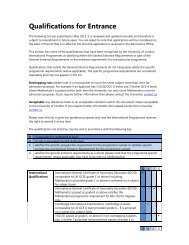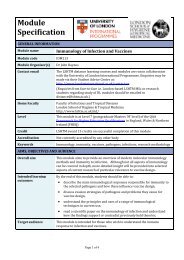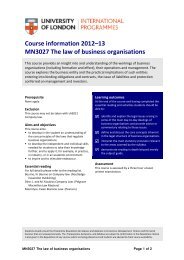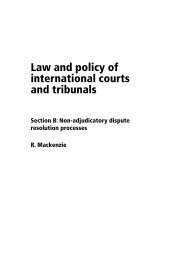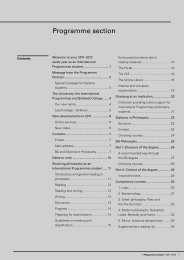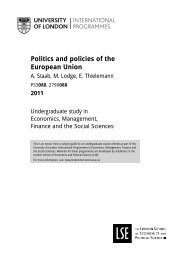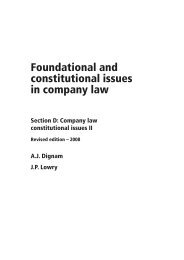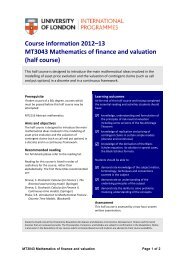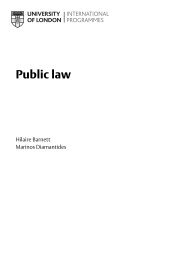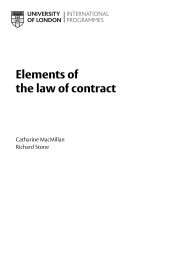Introduction to computer systems architecture and programming
Introduction to computer systems architecture and programming
Introduction to computer systems architecture and programming
You also want an ePaper? Increase the reach of your titles
YUMPU automatically turns print PDFs into web optimized ePapers that Google loves.
168 <strong>Introduction</strong> <strong>to</strong> <strong>computer</strong> <strong>systems</strong> <strong>architecture</strong> <strong>and</strong> <strong>programming</strong><br />
2. Convert the following numbers in<strong>to</strong> binary numbers <strong>and</strong> add them. Convert the result<br />
back in<strong>to</strong> decimal <strong>to</strong> check your result.<br />
• 999 10<br />
• 256 10<br />
Binary subtraction<br />
In order <strong>to</strong> subtract one binary number from another we can again use the<br />
procedures we are familiar with from the decimal system. For example:<br />
10011 2<br />
– 1111 2<br />
64s 32s 16s 8s 4s 2s 1s<br />
1 0 0 1 1<br />
− 1 1 1 1<br />
Borrowed: 1 1<br />
Result: 0 0 1 0 0<br />
So we start from the least significant bits on the right where we deduct 1<br />
from 1 <strong>and</strong> get a result of 0. The next column is also straightforward. In<br />
the third <strong>and</strong> fourth columns we need <strong>to</strong> borrow 1 from the column on the<br />
left.<br />
However, it is quite difficult for a <strong>computer</strong> <strong>to</strong> carry out subtraction in this<br />
(so familiar <strong>to</strong> us) way. A more <strong>computer</strong>-friendly approach that has been<br />
proposed relies on the idea of turning the number <strong>to</strong> be subtracted in<strong>to</strong> its<br />
negative counterpart (referred <strong>to</strong> as its two’s complement) <strong>and</strong> then<br />
adding this negative using ordinary addition. (Please note that although<br />
you should be aware of the concept of representing the two’s complement<br />
of a binary number, a detailed knowledge of how the two’s complement<br />
can be determined is beyond the material covered in this course.)<br />
A further well-known method that can be used <strong>to</strong> represent a negative<br />
binary number is the sign <strong>and</strong> magnitude method. This method<br />
follows the concept used within mathematics where negative numbers are<br />
represented by using the minus sign as a prefix. As the binary numbers<br />
used with <strong>computer</strong>s do not have any extra symbols, an easy way <strong>to</strong><br />
represent a negative number is <strong>to</strong> agree that the left-most bit is just the<br />
equivalent of a +/− sign, <strong>and</strong> the remainder of the number indicates the<br />
value, i.e. the magnitude of the number:<br />
• 0 indicates that the number is positive<br />
• 1 indicates that the number is negative.<br />
For example, in an 8-bit representation of binary numbers 00001100 2<br />
would represent 12 10<br />
<strong>and</strong> 10001100 2<br />
would be −12 10.<br />
Although the sign <strong>and</strong> magnitude method has been used in early<br />
<strong>computer</strong>s <strong>and</strong> may still be used within the representation of floating-point<br />
numbers, the advantage of the two’s complement is evident: The two’s<br />
complement representation allows us (or more importantly the <strong>computer</strong>)<br />
<strong>to</strong> carry out subtraction through a combination of negation <strong>and</strong> addition.<br />
This means that a <strong>computer</strong>’s electronic circuits that are designed <strong>to</strong> carry<br />
out addition can also be used for subtraction. You will learn more about<br />
these circuits in the next section.<br />
Reading<br />
Now read Brookshear (2009) Chapter 1, sections 1.2, 1.4–1.6 <strong>and</strong> 1.8.<br />
26



